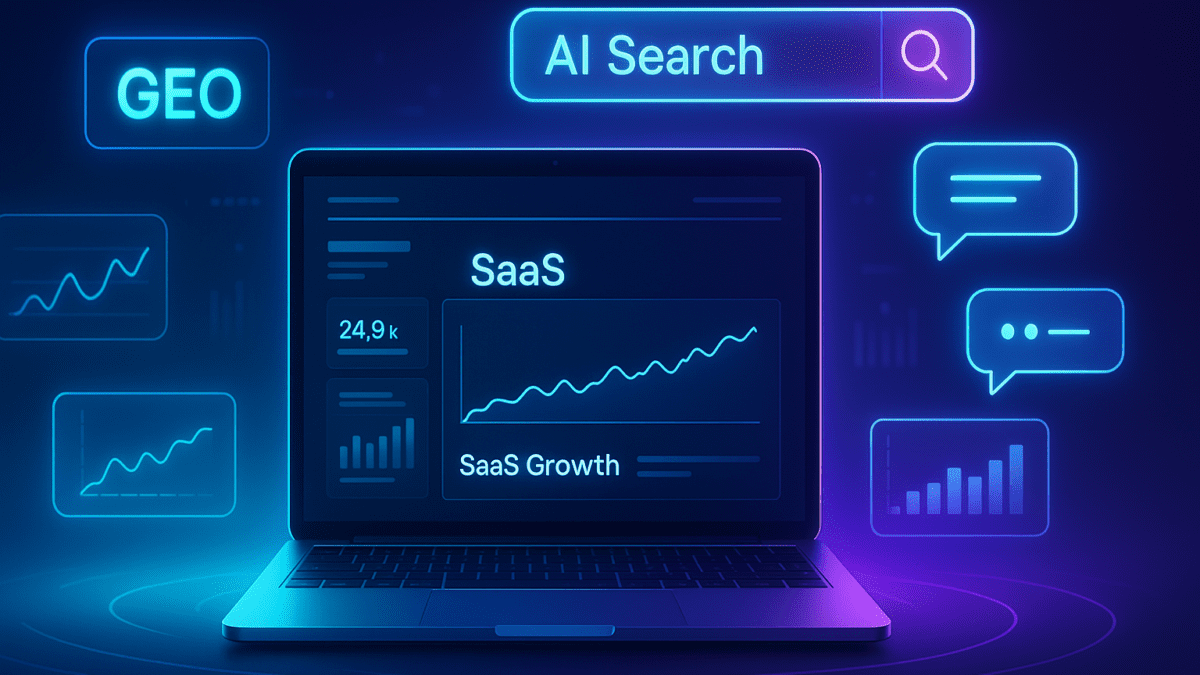How Generative Engine Optimization (GEO) is Evolving SaaS in 2025
Table of Contents
Introduction
For over two decades, SaaS companies have relied heavily on SEO-driven inbound marketing to acquire leads. Blogs, gated whitepapers, and search-optimized landing pages have been the backbone of growth. But in 2025, the search landscape has dramatically shifted.
With the rise of AI-powered search engines like ChatGPT, Perplexity, Bing Copilot, and Google Gemini’s Search Generative Experience (SGE), users no longer browse long lists of links. Instead, they expect direct, AI-generated answers.
This evolution has created a new discipline—Generative Engine Optimization (GEO)—and SaaS companies are among the first to feel its impact.
What is Generative Engine Optimization (GEO)?
Generative Engine Optimization (GEO) is the process of optimizing content so that AI-driven search engines reference and recommend your brand within their generated answers.
Unlike traditional SEO, where ranking on Google’s first page was the goal, GEO focuses on ensuring:
- Your SaaS brand is recognized as a trusted entity.
- Your content is structured for AI training models.
- Your product and expertise are referenced in conversational search results.
For SaaS companies, this means a fundamental shift in content strategy, distribution, and lead generation.
Why GEO Matters for SaaS Growth
SaaS Buyers Use AI Search
Decision-makers no longer Google “best CRM software.” Instead, they ask Copilot:
“What’s the best CRM for mid-market SaaS companies with AI features?”
If your brand isn’t optimized for GEO, you risk being excluded from AI-generated recommendations—even if you rank high on Google.
- Traditional SEO is Losing Visibility: Studies show generative engines reduce organic clicks by 30–40%, since answers are provided directly. SaaS brands that relied on blog traffic or SEO-driven whitepapers are now seeing fewer visitors.
- High-Value SaaS Deals Come From Trust: SaaS buying cycles are long, with multiple stakeholders involved. GEO helps brands establish authority and trust by ensuring they’re referenced in AI-driven content, giving them an edge early in the evaluation process.
How GEO is Evolving SaaS Marketing
Entity Optimization for SaaS Brands
AI engines rely on entities (companies, products, people) in their knowledge graphs. SaaS companies must:
- Ensure their brand is listed on Wikidata, Crunchbase, G2, Capterra, LinkedIn.
- Use schema markup (Product, Organization, Software Application).
- Maintain consistent Name, Address, Phone (NAP) across listings.
This makes the SaaS product more discoverable in AI-generated answers.
AI-Friendly Content Formats
SaaS companies must adapt content for machine readability:
- Structured FAQs (e.g., “What is Aalign CRM?” “How does Aalign pricing work?”).
- Data-rich case studies, reports, and benchmarks.
- Multimedia content (videos, infographics, transcripts) to fuel multimodal AI engines.
Example: A SaaS company publishing “2025 SaaS Benchmarks Report” has higher chances of being referenced in GEO-driven answers than a standard blog.
From Keywords to Conversations
Instead of targeting keywords like “best email marketing SaaS”, GEO requires targeting user questions and intent:
- “What SaaS tool helps with AI-driven ABM?”
- “Which SaaS CRM integrates with Microsoft Teams?”
- “How can SaaS founders reduce churn with automation?”
SaaS content must be structured around real buyer questions, not just keyword density.
Integrating GEO into SaaS ABM (Account-Based Marketing)
GEO complements SaaS ABM strategies:
- AI search engines provide personalized recommendations for industries.
- SaaS marketers can optimize whitepapers, case studies, and demos so AI tools reference them for specific buyer personas.
- Example: “Best HR SaaS for remote startups” → AI should surface your HR Tech SaaS case study if optimized for GEO.
Trust Signals for AI Engines
Generative engines evaluate EEAT (Experience, Expertise, Authority, Trust) before recommending SaaS products. Companies must:
- Highlight authorship (CTO blog posts, founder thought-leadership).
- Publish transparent pricing and reviews.
- Use trust badges, ISO certifications, SOC 2 compliance.
For SaaS, compliance certifications are not just for buyers—they help AI rank credibility.
SaaS Use Cases of GEO in Action
- CRM SaaS: Optimizing case studies like “How mid-market SaaS firms use CRM to cut churn by 25%” ensures AI recommends them in queries about churn reduction.
- FinTech SaaS: Publishing benchmark reports on “2025 SaaS Payment Trends” positions them as a cited authority in AI finance searches.
- HR Tech SaaS: Creating interactive guides on “Skills-first hiring SaaS platforms” ensures visibility in AI-powered talent acquisition queries.
How SaaS Teams Can Implement GEO Today
- Audit Brand Presence: Check if your SaaS is listed in AI-trusted sources (Wikipedia, Crunchbase, G2).
- Restructure Content: Convert blogs into Q&A, FAQ, and AI-readable reports.
- Invest in EEAT: Showcase founders, publish compliance docs, display client case studies.
- Monitor Mentions: Use tools like Perplexity Analytics to see if your SaaS is cited in AI search.
- Experiment with AI Search Ads: Platforms will soon allow GEO-based ads (sponsored AI citations).
Conclusion: GEO is SaaS Marketing 2.0
Generative Engine Optimization is not replacing SEO—it’s evolving it. For SaaS brands, GEO is the new growth lever: ensuring their solutions appear in AI-driven conversations, recommendations, and insights.
The SaaS companies that adapt now will win not just visibility, but also trust and conversions in an AI-first world.
SEO got SaaS noticed. GEO will get SaaS recommended.
Ready to amplify your content’s impact? With iTMunch’s B2B Content Syndication Services, your whitepapers and reports don’t just sit on your website—they reach the right decision-makers, drive engagement, and fuel growth. Get started today →
You May Also Like: From Content Asset to Conversion Hub: Why Portals Are the New Landing Pages





